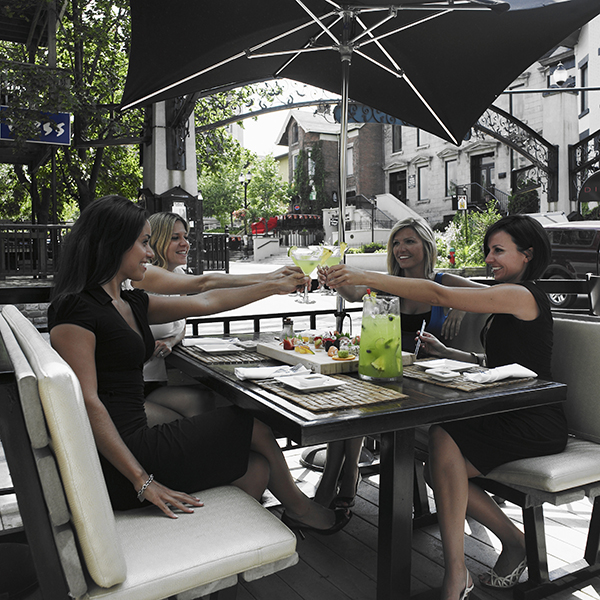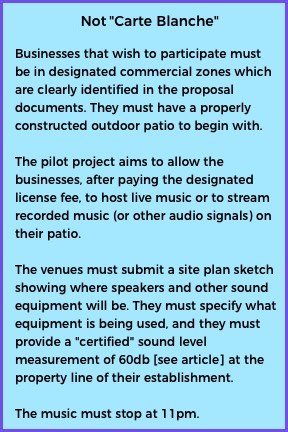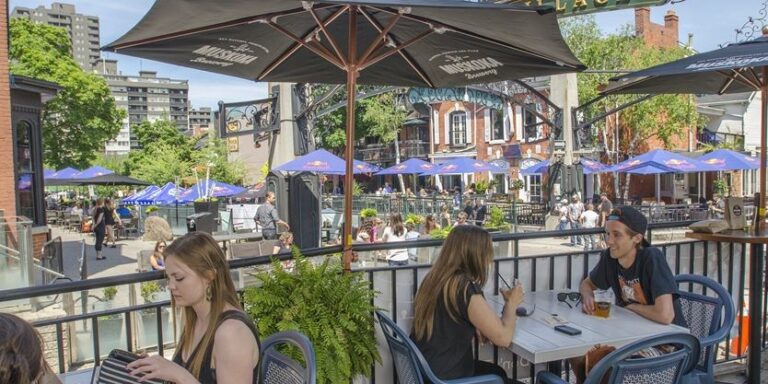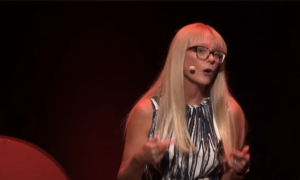
Music on outdoor patios is a wonderful thing. If you’re the owner of a licensed establishment, adding tasteful and appropriate music on your outdoor patio is the perfect way to create a relaxing, pleasant, and fun environment in that special outdoor place.
The City of Hamilton is about to implement a 24 month pilot project that will give musicians a great new opportunity: performing on an outdoor commercial patio.
For the first time ever, thoughtful establishments can expand their delivery of great entertainment onto the fresh air patio environment. Those summer nights can now beckon Hamiltonians and their visiting family and friends to go out and enjoy some fine food and entertainment under the warm summer skies!

By definition, the City says an outdoor commercial patio is “any outdoor area used in conjunction with any establishment licensed under the Liquor License Act, where meals or refreshments are served to the public for consumption on the premises.”
Outdoor Commercial Patios do not include:
- Café with several tables and chairs in the front or back yard
- Patios associated with Restaurants that do not have a liquor license
The pilot project will amend the Zoning Bylaws and Noise Bylaws with the effect of permitting entertainment on outdoor commercial patios. It is expected that the pilot project will result in Pro-active and re-active enforcement initiatives with regard to achieving compatibility amongst adjacent commercial / residential land uses. In this pilot program there “must be an emphasis toward educating and negotiating compliance to provide a balanced approach before commencing any legal action”.
My Own (Moderate) View
When I think about outdoor entertainment I’m limiting my own views to encompass a particular type of venue: a venue in a dense area commercial area that is adjacent to a residential neighbourhood. (The rural addresses –mostly golf course clubhouses – in this study are less affected by the proximity of surrounding residential areas. And yet, the conditions of the license will still apply to them.)
While the by-law amendment allows for dance facilities, which implies a robust sound amplification setup, I’m not about to push for a full stage setup with speakers including subs to amplify a five-piece band. I’m also hesitant to support a deejay setup in the outdoors which, in my opinion, implies an amplification of booming rhythmic bass lines and drums. Low frequency sounds carry a long ways and are more difficult to mitigate with sound barriers. It might work in a rural setting where the neighbours are a quarter mile away, but how could one make a reasonable case for sub-woofers and disco balls outdoors when people may be living just a few dozen yards away? I don’t visualize outdoor dance areas at all. Others may have a different view and that’s fine with me.
In my moderate view I’m envisioning a solo, duo or trio act, with an acoustic vibe, minimal PA system that functions as “light entertainment” or “background music/entertainment”.
A moderate view is essential considering that before this special pilot project came into consideration, there was NO entertainment allowed on outdoor patios in Hamilton. What sort of outdoor entertainment makes sense? What new experiences are Hamilton business owners willing to “dump into the laps” of their residential neighbours? We can’t for a second think that this pilot project allows “carte blanche” to a venue to do anything they want. On the contrary, we need to think of win-win scenarios.
 I’m Proud Of Hamilton For Taking This On
I’m Proud Of Hamilton For Taking This On
The very fact that our City has undertaken this 24 month pilot project makes me proud.
It means that our city staff aren’t just responding to gut level feelings about what should happen with musical entertainment and other late-night, urban activities. They want real data, and they want to present real information to our council about what works and what doesn’t.
Hamilton is not a small town. Hamilton is not a suburb. Hamilton is pursuing its vision of being a progressive, vibrant cultural centre that enables rich expressions of the arts, including music, and rich expressions of night life. (It is also the best place to raise a child, to which I can attest three times over!)
At a time when municipalities across Canada (Halifax, Montreal, Ottawa, Toronto, Hamilton, London, Calgary, Vancouver) are jumping up and claiming to be music cities, I’m proud to know that Hamilton has set up this pilot project to allow us to see what actually happens.
In the pilot project, participating businesses will pay a license fee of $300, and will have to conform to the amended Noise Bylaw which has specific requirements. Bylaw enforcement will continue to be managed by bylaw officers. Important data will be gathered and will inform decisions about whether or not the program is realistic, enforceable and worth continuing.
If we don’t allow venues to have the opportunity to test the market and work out the details of how to appropriately, and respectfully, put amplified entertainment in their outdoor spaces, we will never have reliable data on what works and what doesn’t. We would never be able to stand tall as a “City of Music” and move forward with confidence in our bylaws and business regulations.
Bravo to the City of Hamilton for taking on this issue. By the end of this 24 month pilot project, Hamilton will be the expert on entertainment on outdoor commercial patios!
This will be a major learning opportunity and a significant milestone in our journey to becoming a leading city in the Canadian and international music industry.
My Delegation To Planning Committee
This coming Tuesday, April 18, I will be presenting a delegate’s report to the City Planning Committee in relation to the proposed pilot project.
Here’s my issue:
60db sound levels would be impossibly low to maintain for almost all downtown sites, simply due to the normal existence of typical background sounds in the urban core.
A passing car generates 65db of sound pressure, typically. A Harley passing by could easily spike to 90db or more. An outdoor patio filled with groups bubbling in conversation is definitely not going to measure at 60db which is comparable to “an office conversation.” More likely it will average in the area of 65db.
The way the decibel scale works, 70db is “twice as loud” as 65db. Examples of sounds at the 70db level are
Passenger car at 65 mph at 25 ft (77 dB); freeway at 50 ft from pavement edge 10 a.m. (76 dB). Living room music (76 dB); radio or TV-audio, vacuum cleaner (70 dB).
http://www.industrialnoisecontrol.com/comparative-noise-examples.htm
The upper 70s are “annoyingly loud to some people.”
The reality is, that within the context of an urban outdoor patio that is situated not far from a street, a musician would need to have a general, average level of amplification that matches or exceeds the surrounding environment.
Our ears perceive sound in many subjective ways, depending on many things, including our mood, whether or not we want to hear the sound or not, whether or not we are trying to carry on a conversation, and whether or not the sound is regular and patterned (such as music) or irregular and unpredictable (such as machinery or construction work).
My submission will recommend that the wording of the proposed Noise Bylaw amendment be adjusted to reflect a more realistic sound measurement level of 65db for these outdoor commercial patios. This would give them a fighting chance to actually succeed at what they are hoping to accomplish, which is create a tasteful and enjoyable outdoor experience which includes music played at a reasonable level, and that respects normal sound levels for background music.
I believe our local businesses are run by intelligent and thoughtful citizens. They want to succeed in supporting the vibrancy of their neighbourhood. They want to be good neighbours and good corporate citizens. Our venues need a patio entertainment license program that will be reasonable and which reflects their ability to make good decisions as they work with the musicians they hire to keep the experience enjoyable for everyone.
There will be other delegations and presenters at the Planning Committee meeting. Some will be pro, others will be con.
You are welcome to attend the meeting.
Planning Committee
9:30 a.m.
Tuesday, April 18, 2017
Hamilton City Hall
Council Chambers, 2nd Floor
71 Main Street West, Hamilton
Additional information
Areas affected:
- Hess Village (PDF, 583 KB)
- Downtown Hamilton (PDF, 583 KB)
- Augusta Street (PDF, 418 KB)
- James Street North (PDF, 597 KB)
- Hamilton West Harbour (PDF, 488 KB)
- Upper James Street (PDF, 459 KB)
- Downtown Dundas (PDF, 439 KB)
- 268, 276, & 281 Carlisle Rd
- 523 Carlisle Rd
- 342 8th Con Rd E
- 1039 5th Con Rd W
- 787 Old Hwy 8
- 1079 Hwy 8
- 167 Hwy 5 W
- 1211 2nd Con Rd W
- 1472, 1468, & 1450 2nd Con Rd W
- 71 Hwy 52
- 1707 Jerseyville Rd W
- 166 Green Mountain Rd
- 2787 Dunmark Rd
- 1276 Shaver Rd & 914 Book Rd W
- 8229 English Church Rd
- 9639 Chippewa Rd
- 185 Golf Club Rd
- 4349 Hwy 56





